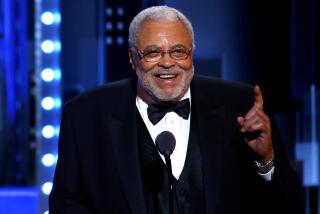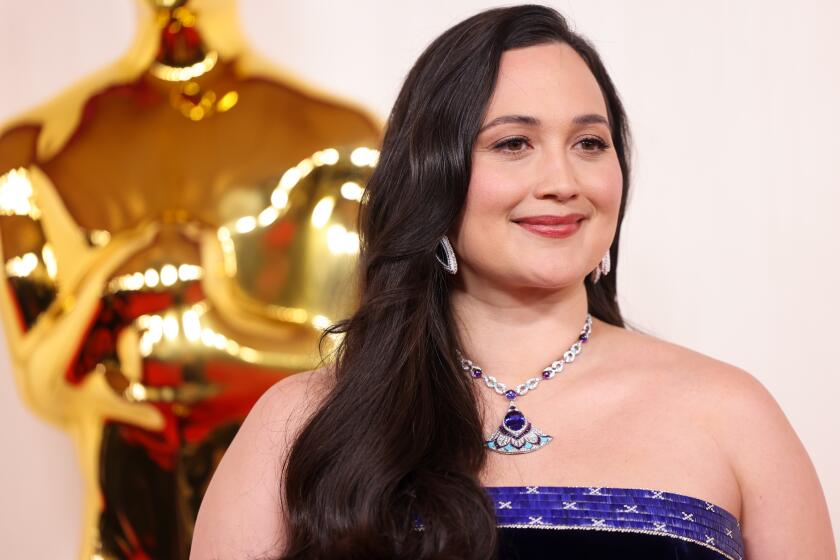Scribe’s dogged route to ‘Ray’
The other day James L. White gave me a tour of the place where he spent his first decade trying to make a living in Hollywood. It’s a tour every wannabe screenwriter should take so they could measure the vast distance that lies between taking a first crack at telling a story and creating a film that not only touches people’s souls but earns an Oscar best picture nomination. Or as White put it as we climbed the paint-spattered back stairs of a nondescript building in the heart of Santa Monica, the barks and yelps of dogs echoing in the background, “Welcome to the Wilshire Animal Hospital School of Screenwriting.”
Today White is a storybook success story, a man probably past 50 (he won’t give his exact age) who after decades of struggle has seen his first produced script, “Ray,” earn six Oscar nominations and a raft of critical praise. That the film academy in all its wisdom managed to honor White’s movie but not his screenplay may be an injustice, but he has no intention of dwelling on the snub, especially at a time when the industry has taken a newfound interest in his career. He’s in demand all over town, with “Ray” star Jamie Foxx wanting to work with him again, Ice Cube reading one of his scripts and Denzel Washington eager to take a meeting.
It’s a heady experience for White, who spent a decade learning his trade in a cramped apartment above the Wilshire Animal Hospital, where his wife, Liz, who now teaches veterinary technology, worked as an off-hours technician in exchange for the rent-free apartment. The couple’s bedroom has been turned into a storage facility. “I learned how to rewrite scripts right here,” White says, pointing to a corner cluttered with boxes of dog medicine. He points out a screen door at the tarpaper rooftop, dotted with heating ducts, with a view of a Jack in the Box next door. “That’s where we’d barbecue at night,” he says. “I’d be up here writing and I’d hear the growls of dogs coming up the stairs and I’d say, ‘The animal hospital is next door!’ ”
Everyone has their reasons for becoming a writer. For White, an unpretentious man with an easy laugh who’s known to his friends as Jimmy, storytelling wasn’t so much an art as a way of asserting a belief in himself. Born in Mount Sterling, Ky., a tiny hamlet 35 miles east of Lexington, White was raised first by his young mother, then his grandmother Ada B. White. “I didn’t have a dad,” he says over lunch at a cafe down the street from the hospital. “My father was someone my mother knew who attacked her, and out of that violence I was conceived. Even though I was this really dark guy in a light-skinned black family, my mother wanted me and she kept me.”
It was as a child, having to endure the taunts of kids who would chant “Who’s your daddy?,” that White first tried his hand at storytelling. “I’d come up with someone who was famous, like Jackie Robinson or Bill Cosby, and I’d say they were my daddy. I’d make up all kinds of stories so I’d have something to say back to them.”
When he was 4, his mother married, but his stepfather said there was no room in his house for White. He went to live with his grandmother, who worked as a domestic, doing ironing and cleaning. The opening scene of “Ray,” which shows Ray Charles’ mother airing out sheets, was written from White’s memories of seeing his grandmother doing the same thing. In fact, there are many images in the film of the singer’s childhood in the Depression-era South that are strikingly similar to White’s memories of rural 1960s Kentucky. His grandmother didn’t have indoor plumbing until the early 1980s. When White was growing up, he’d take a bath by heating the water on the stove and pouring it into a tub.
Much of the town was segregated, marked with “whites only” signs that didn’t come down until the 1970s. When White would see movies on Saturday night at the town theater, he had to go through a “colored” entrance on the side and sit upstairs in the balcony. “To use the bathroom, you had to walk down to the train station, and if that bathroom wasn’t open, you had to go between the boxcars.”
He saw classic films featuring such stars as Paul Newman and Burt Lancaster, though none with Sidney Poitier, at least not ones where the black actor appeared in scenes with a white woman. “They wouldn’t book a film like that,” White says. “My cousin once got in trouble just for looking at a poster of a jungle movie because it had a scantily clad white woman in it.” The movies that did come often stayed for months, so White got a chance to watch them over and over, studying the storytelling process.
He especially loved “Midnight Cowboy.” “Seeing Joe Buck, getting out of that small town -- I totally identified with that,” he recalls. “That movie really helped me want to be a writer.”
After high school, White joined the Navy, then went to college at the University of Massachusetts. After knocking around at a variety of jobs, he moved to Los Angeles in the late 1970s and began learning the craft of writing. His progress was slowed considerably because he had something else in common with Charles, whom White invariably refers to as Mr. Charles: He was a heroin addict.
“In Boston, I became a health inspector and a junkie at the same time,” he says. “It was stupidity, just me trying to prove I was hip like everyone else. Mr. Charles and I talked about that a lot, having the same reasons for turning to drugs.” Like Charles, White wasn’t the stereotypical nod-out-in-the-corner junkie. “I often worked three jobs at a time, but I always cashed my paycheck at the dope man’s house.”
White finally looked in the mirror one night and scared himself. “I saw this weird-looking man I didn’t know,” he recalls. “I looked a lot like Gollum from ‘Lord of the Rings.’ ” In 1985, when his wife said she was taking their baby and leaving him, White kicked junk just as Charles did, on his own. “The thought of losing her, or my son being like me, was too horrible to imagine,” says White, who has two daughters and a son. Since then, he’s been clean and sober, but it took years to develop the discipline needed to be a writer. By the early 1990s he had script samples to show around. His first serious meeting was with Stuart Benjamin, a producer who thought White would be perfect to write a movie about Charles but had no money to pay for a script.
White found other work, writing a movie for Poitier, his childhood idol, and a TV film about Bo Jackson. But none of the projects was ever produced. Finally, in early 2000, Benjamin called and posed a question: How would you like to write about an old broken-down piano player? White said, “Who are you talking about?” Benjamin replied, “Ray Charles.” Benjamin was convinced that White was the right man for the job, not only because he’d become an accomplished writer but, having fought many of the same demons as Charles, he wouldn’t sanitize the film’s hero with saintly cliches, as often happens in Hollywood films about African Americans.
It took four more years to get the movie made, but White never faltered, even when auditioning for the writing job with the notoriously prickly R&B; legend. “I almost flunked the test,” he recalls. “I was determined not to have a Poitier moment” -- he’d almost passed out the first time he met Poitier -- “so I kept very calm and said, ‘The type of movie I should write is a love story. What do you think?’ And Mr. Charles said right back at me, ‘You’re the writer. What do you think?’ ”
When White fumbled for an answer, Charles asked where he was from. Hearing the writer grew up in small-town Kentucky, Charles said, “Oh, you’re a country boy. You like tomato pie?” Within minutes, Charles had his wife on the phone, ordering the fixings for a tomato pie. “After that, he opened up to me. We’d talk all the time, and whenever I was struggling with a scene, he’d say, ‘Jimmy, you know how to do it. You’ve been there. “
After reading White’s evocative script for “Ray,” the only mystery is how White managed to go so many years without having a screenplay make it to the screen. According to Benjamin, the biggest obstacle has been White’s subject matter. “Jimmy writes serious dramas with African American protagonists, which happen to be the pieces that are the toughest to make in Hollywood. If you put aside biographical films like ‘Ray’ or ‘What’s Love Got to Do With It,’ when it comes to black drama, it’s an awfully short list.”
White was on the “Ray” set virtually every day during filming, though his most distinct memory is being on hand for the first read-through of the script. “The first time I heard Jamie Foxx say the words, I cried like a baby,” he recalls. “I remember Jamie lowering his dark glasses and saying, ‘Are you crying?’ And I said, ‘No, I am not.’ But he knew I was and when we were shooting the film, after he’d do a scene, he’d look around the set and say, ‘I just want to know -- is Jimmy crying?’ ”
The Big Picture appears Tuesdays in Calendar. Comments and suggestions can be e-mailed to patrick.goldstein @latimes.com.
More to Read
Only good movies
Get the Indie Focus newsletter, Mark Olsen's weekly guide to the world of cinema.
You may occasionally receive promotional content from the Los Angeles Times.










